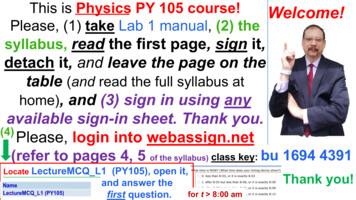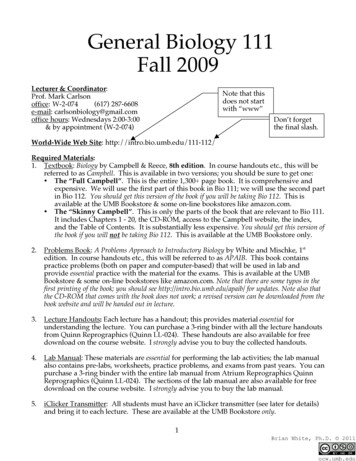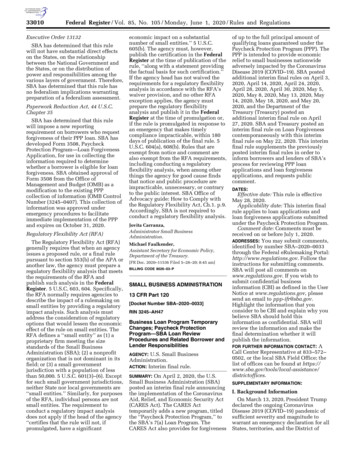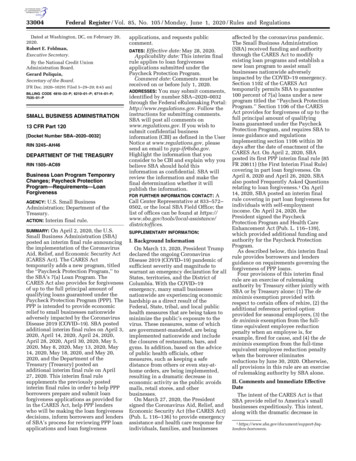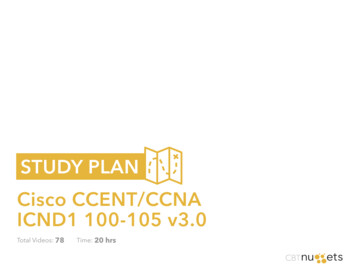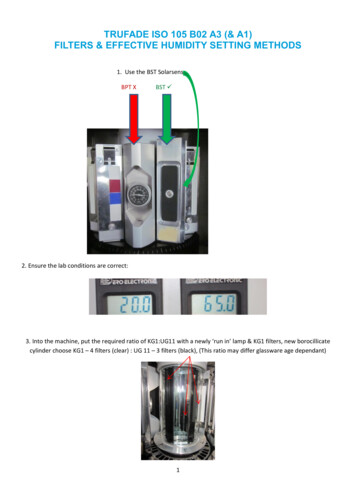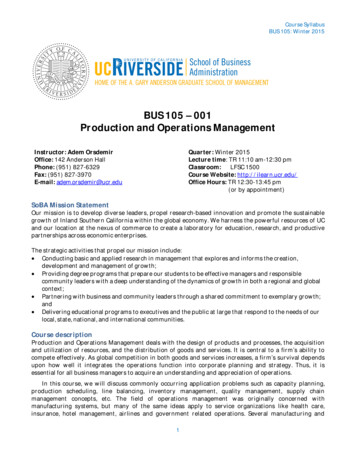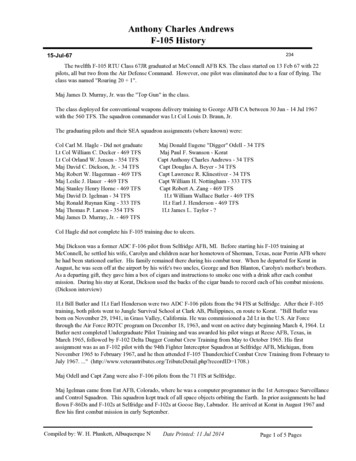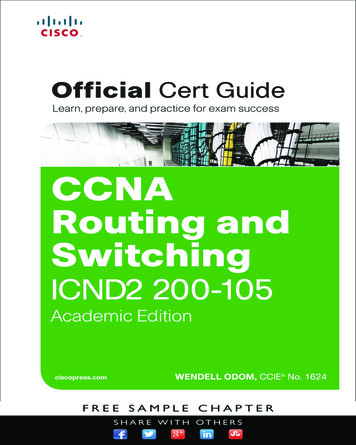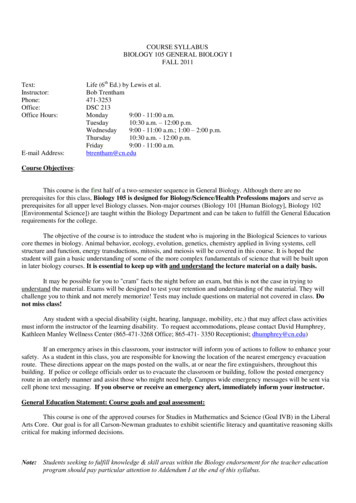
Transcription
COURSE SYLLABUSBIOLOGY 105 GENERAL BIOLOGY IFALL 2011Text:Instructor:Phone:Office:Office Hours:E-mail Address:Life (6th Ed.) by Lewis et al.Bob Trentham471-3253DSC 213Monday9:00 - 11:00 a.m.Tuesday10:30 a.m. – 12:00 p.m.Wednesday9:00 - 11:00 a.m.; 1:00 – 2:00 p.m.Thursday10:30 a.m. - 12:00 p.m.Friday9:00 - 11:00 a.m.btrentham@cn.eduCourse Objectives:This course is the first half of a two-semester sequence in General Biology. Although there are noprerequisites for this class, Biology 105 is designed for Biology/Science/Health Professions majors and serve asprerequisites for all upper level Biology classes. Non-major courses (Biology 101 [Human Biology], Biology 102[Environmental Science]) are taught within the Biology Department and can be taken to fulfill the General Educationrequirements for the college.The objective of the course is to introduce the student who is majoring in the Biological Sciences to variouscore themes in biology. Animal behavior, ecology, evolution, genetics, chemistry applied in living systems, cellstructure and function, energy transductions, mitosis, and meiosis will be covered in this course. It is hoped thestudent will gain a basic understanding of some of the more complex fundamentals of science that will be built uponin later biology courses. It is essential to keep up with and understand the lecture material on a daily basis.It may be possible for you to "cram" facts the night before an exam, but this is not the case in trying tounderstand the material. Exams will be designed to test your retention and understanding of the material. They willchallenge you to think and not merely memorize! Tests may include questions on material not covered in class. Donot miss class!Any student with a special disability (sight, hearing, language, mobility, etc.) that may affect class activitiesmust inform the instructor of the learning disability. To request accommodations, please contact David Humphrey,Kathleen Manley Wellness Center (865-471-3268 Office; 865-471- 3350 Receptionist; dhumphrey@cn.edu)If an emergency arises in this classroom, your instructor will inform you of actions to follow to enhance yoursafety. As a student in this class, you are responsible for knowing the location of the nearest emergency evacuationroute. These directions appear on the maps posted on the walls, at or near the fire extinguishers, throughout thisbuilding. If police or college officials order us to evacuate the classroom or building, follow the posted emergencyroute in an orderly manner and assist those who might need help. Campus wide emergency messages will be sent viacell phone text messaging. If you observe or receive an emergency alert, immediately inform your instructor.General Education Statement: Course goals and goal assessment:This course is one of the approved courses for Studies in Mathematics and Science (Goal IVB) in the LiberalArts Core. Our goal is for all Carson-Newman graduates to exhibit scientific literacy and quantitative reasoning skillscritical for making informed decisions.Note: Students seeking to fulfill knowledge & skill areas within the Biology endorsement for the teacher educationprogram should pay particular attention to Addendum I at the end of this syllabus.
Attendance:College policy requires students to attend all classes and daily attendance will be taken. If a studentmisses more than 12 regular classes, for any reason, that student will be dropped from the course and will earna failing grade. Attendance is also required on test dates. Only verifiable medical or legal excuses will be accepted asreasons for missing a test, otherwise, missed exams will count as zero. Permission for missing a test should beobtained from Dr. Trentham prior to your absence where possible. Generally, no make-ups will be given.Attendance will be taken in lab as well. Students are required to attend all labs. If a student misses two labs,the student’s overall final grade for the course will be reduced 10 %. A third miss will cause the student to be droppedfrom the course, failing the class.Grading:Four one-hour lecture exams will be given at prescribed times during the semester. A comprehensive finalexam will be given during finals week. Lab work will also comprise an integral part of the overall grade. Each studentwill be expected to maintain an organized portfolio of their work (i.e. - notes, lab assignments, etc.) throughout thesemester! The portfolio will be utilized as a reference in future upper division Biology courses. These portfolioswill be checked at of the four regular exam dates!90 – 100%80 – 89%70 – 79%60 – 69%Below 60 A B C D F4 - one hour lecture exams (100 points each)12 - Lab assignments & writing assignments1 - Comprehensive final1 – PortfolioTotal 400 pts. 180 pts. 100 pts. 40 pts. (10 pts/review) 720 pts.Test & Portfolio Review Schedule1st Hour Exam & Portfolio Review2nd Hour Exam & Portfolio Review3rd Hour Exam & Portfolio Review4th Hour Exam & Portfolio ReviewFinal Exam (Section A)Monday, Sept. 19Monday, Oct. 10Wednesday, Nov. 9Monday, Dec. 5Monday, Dec. 12 Exam on Chapters 1 and 42-46 (Ecology) Exam on Chapters 2-8 (Cells) Exam on Chapters 15-19 (Genetics) Exam on Chapters 9-14 (Evolution) 8:30 – 10:30 a.m. (Comprehensive)Also, please note in the fall 2011 schedule the following dates:ConvovationTue., Aug 30 *9:30 a.m., Holt FieldhouseLast day to add, change, or drop a course without receiving a gradeWed., Aug. 31Midterm grades turned inFri., Oct. 14Last day to drop and receive a WWed., Nov. 2(Courses dropped after this date will receive a WF)Dr. Trentham reserves the right to change this syllabus/grading procedure. The class will be notified verbally ofsuch changes. NO "extra credit" projects are allowed. Your grade will be based on the criteria specified above.If you are having trouble with the course, see the instructors or contact the Academic Support Center (early inthe semester - don't wait until the end of the semester). If you are absent from class, it is your responsibility toobtain what was covered, assignments, announcements, etc. Any questions and/or concerns about a gradereceived must be brought to the attention of your instructor within one week of receiving that grade - otherwisethe grade will stand.
POLICY ON PLAGERISM: Written assignments, including lab work, must be written in the student’s own words. Any writing whichbears too close a resemblance to another student’s work or any published reference materials will not beaccepted and a grade of zero will be recorded for the assignment. Consult pages 61-64 of the CN Writing Guide (Fifth Edition) for examples of plagiarism. Please note thatproviding a citation at the end of a sentence or paragraph only gives you permission to present factualinformation you obtained from that source. Even when a citation is given, just “changing words hereand there” is still plagiarism and will not be accepted.Minimum penalty for cheating and plagiarism will be a zero for that work.No cell phone or laptop use in class. Do not bring cell phones to class or lab, they will be confiscated!No grades will be discussed via e-mail or phone.LECTURE SCHEDULETOPICAn Introduction/what is Life?Behavioral EcologyPopulation EcologyCommunity Ecology & EcosystemsBiomes & Aquatic EcosystemsEnvironmental ChallengesCHAPTER14243444546 (1ST Hour Exam) EcologyOf Atoms & Molecules: Chemistry BasicsLife ChemistryCells: Units of LifeCell Surfaces and CytoskeletonThe Energy of LifeHow Cells Release Energy234568 (2nd Hour Exam) CellsThe Cell Cycle & Cell DivisionMeiosisTransmission of Inherited TraitsChromosomesDNA Structure & ReplicationGenetic Technology91011121314 (3rd Hour Exam) GeneticsThe Evolution of the Evolutionary ThoughtThe Force of Evolutionary change, microevolutionSpeciation & ExtinctionEvidence for EvolutionThe Origin of History of Life1516171819 (4th Hour Exam) Evolution
LAB SCHEDULEFALL 2011Week/DayTitle1. Aug 24/25No Lab, First Week of Class2. Aug 31/Sept1Cosmic Voyage Video15 points3. Sept 7/8Ex 51 Animal Behavior15 points*4. Sept 14/15Mossy Creek Quality Assessment15 points*5. Sept 21/22Nat. Select Simulation & Set up Fast Plants15 points*6. Sept 28/ 29Gather and Graph Fast Plants Data15 points7. Oct 5/6Propose and Set Up Fast Plants Inquiry15 points8. Oct 12/13No Labs, Fall Break15 points9. Oct 19/20Collect and Graph Fast Plants Data10. Oct 26/27Present Posters on Fast Plants Inquiry15 points11. Nov 2/3Cells Exercise 415points*12. Nov 9/10Standard Curve15 points*13. Nov 16/17Enzyme Assay, Part I15 points*14. Nov 23/24No Labs, Thanksgiving15. Nov 30/Dec 1Enzyme Inquiry16. Dec 7/8No Labs, Class Ends/ Reading & Study DayTotal PointsAssignment15 points180 possible lab pts.*NOTE: On these weeks, the lab points will be divided into two parts: 5 points at the beginning of laband 10 points at the end of lab. On these weeks, you will be given a 5 point quiz at the beginning of thelab. The quiz will pertain to homework that you receive at the end of the previous week’s lab. At the endof lab you will turn in a 10 point assignment that deals with the material covered that day in lab.
INSTRUCTIONS FOR CONSTRUCTING A BIOLOGY DEPT. PORTFOLIOThe portfolio (notebook) will be a resource collection for your Biology courses (starting with Biology 105 andwill include all upper division biology course work). It should be complete and well organized for easy access tothe compiled information gathered throughout your academic career in the Biology department. Use a threering binder and section dividers for sections, which should include: NotesHandoutsQuizzesHomeworkLab material*Your portfolios should include a table of contents. In addition, a 1-page reflection (written in your own words) onwhat you learned & found interesting in each chapter will need to be included at the end of each chapter section. Besure to include how the chapter's information is relevant to you personally.You may also include any other material that seems appropriate.The portfolios will be graded at mid term and near the end of each semester in Biology 105, according to four Organization-20 pts*Total Points -40 pts.20 pts.** Your portfolio will be checked four times in order to obtain these points
Syllabus Addendum I, for Students Seeking Teacher Licensure in Grades 7-12Knowledge and Skills covered in this course:Understand cellular organelles including the structure of DNA and the internal biochemical processes associated withtheir interaction within an organism, including photosynthesis and cellular respiration.Understand the structure and function of the human body.Operate laboratory instrumentation, including the compound and dissecting microscopes.Recognize taxonomic divisions of organisms and identify examples of each within the biological community.Identify characteristics of vertebrates and invertebrates and behaviors of such organisms.Identify characteristics on non-vascular and vascular plants and understand their physiology.Understand the major concepts and principles of life and environmental science.Understand the unifying concepts of science such as scale and model, form and function, organization, interactions,change and conservation, and be able to apply them to science teaching.Use a variety of technologies, such as hand tools, measuring instruments, calculators, and computers to collect,analyze, and display data.Design and conduct inquiry-based, open-ended investigations – both laboratory and field-based – in a learningenvironment that maintains an appropriate level of safety.Relate the major concepts of the various science disciplines to each other and show how these disciplines areinterconnected.Demonstrate processes of science such as posing questions, observing, investigating phenomena, interpreting findings,communicating results, and making judgments based on the evidence.Apply scientific methods in appropriate situations.Demonstrate a broad general understanding of the major concepts of the discipline they teach.
FALL 2011 LABBIOLOGY 105 LA, LB, LC, LDWRITING AND ORAL PRESENTATION GUIDELINES AND GRADINGGrading Criteria for the AbstractGives the reader a brief summaryBriefly explains the importance of the studyBriefly describes the studyBriefly summarizes the resultsBriefly summarizes the conclusionsGrading Criteria for Introduction/Works CitedAll works cited in the text were listed in the bibliographyAll works listed in the bibliography were used in the textSufficient background was given to orient the readerInformation was given on related earlier researchThe reason for the current research was explained, but not details were given on how theresearch was done or what the results wereGrading Criteria for the Materials and MethodsWould allow interested readers to duplicate the studyWritten in past tenseDoes not reveal any results or conclusionsExplains how data were collected and analyzedUses flowcharts and diagrams as appropriateGrading Criteria for the ResultsIncludes appropriate tables and graphsTables and graphs are properly labeledSummarizes data (range, mean, etc.)Does not simply report “raw data”Does not interpret the results or draw conclusionsGrading Criteria for the DiscussionDraws conclusions from the dataRelates results to earlier studiesDiscusses potential ApplicationsIdentifies potential weaknesses in the dataIdentifies possible directions for future research (changes in methods, new questions, etc.)Grading Criteria for the Final Oral PresentationAll team members participateData supports the conclusionsTransparencies are easy to readTransparencies are well usedPresentation summarizes and critiques the study*Each item in each area is worth 1 points
Total Points 180 possible lab pts. *NOTE: On these weeks, the lab points will be divided into two parts: 5 points at the beginning of lab and 10 points at the end of lab. On these weeks, you will be given a 5
